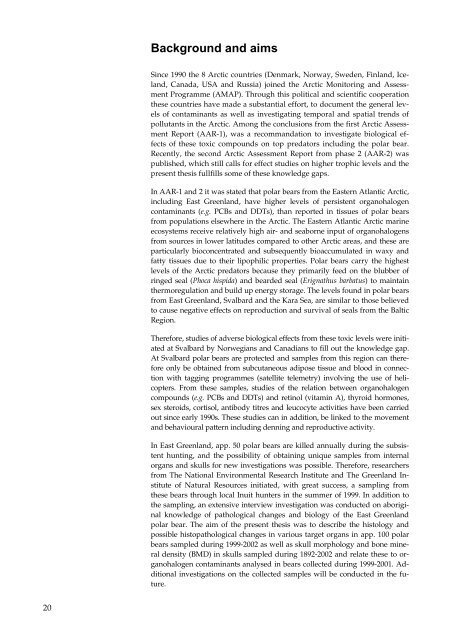Organohalogen concentrations and a gross and histologic ...
Organohalogen concentrations and a gross and histologic ...
Organohalogen concentrations and a gross and histologic ...
You also want an ePaper? Increase the reach of your titles
YUMPU automatically turns print PDFs into web optimized ePapers that Google loves.
20<br />
Background <strong>and</strong> aims<br />
Since 1990 the 8 Arctic countries (Denmark, Norway, Sweden, Finl<strong>and</strong>, Icel<strong>and</strong>,<br />
Canada, USA <strong>and</strong> Russia) joined the Arctic Monitoring <strong>and</strong> Assessment<br />
Programme (AMAP). Through this political <strong>and</strong> scientific cooperation<br />
these countries have made a substantial effort, to document the general levels<br />
of contaminants as well as investigating temporal <strong>and</strong> spatial trends of<br />
pollutants in the Arctic. Among the conclusions from the first Arctic Assessment<br />
Report (AAR-1), was a recomm<strong>and</strong>ation to investigate biological effects<br />
of these toxic compounds on top predators including the polar bear.<br />
Recently, the second Arctic Assessment Report from phase 2 (AAR-2) was<br />
published, which still calls for effect studies on higher trophic levels <strong>and</strong> the<br />
present thesis fullfills some of these knowledge gaps.<br />
In AAR-1 <strong>and</strong> 2 it was stated that polar bears from the Eastern Atlantic Arctic,<br />
including East Greenl<strong>and</strong>, have higher levels of persistent organohalogen<br />
contaminants (e.g. PCBs <strong>and</strong> DDTs), than reported in tissues of polar bears<br />
from populations elsewhere in the Arctic. The Eastern Atlantic Arctic marine<br />
ecosystems receive relatively high air- <strong>and</strong> seaborne input of organohalogens<br />
from sources in lower latitudes compared to other Arctic areas, <strong>and</strong> these are<br />
particularly bioconcentrated <strong>and</strong> subsequently bioaccumulated in waxy <strong>and</strong><br />
fatty tissues due to their lipophilic properties. Polar bears carry the highest<br />
levels of the Arctic predators because they primarily feed on the blubber of<br />
ringed seal (Phoca hispida) <strong>and</strong> bearded seal (Erignathus barbatus) to maintain<br />
thermoregulation <strong>and</strong> build up energy storage. The levels found in polar bears<br />
from East Greenl<strong>and</strong>, Svalbard <strong>and</strong> the Kara Sea, are similar to those believed<br />
to cause negative effects on reproduction <strong>and</strong> survival of seals from the Baltic<br />
Region.<br />
Therefore, studies of adverse biological effects from these toxic levels were initiated<br />
at Svalbard by Norwegians <strong>and</strong> Canadians to fill out the knowledge gap.<br />
At Svalbard polar bears are protected <strong>and</strong> samples from this region can therefore<br />
only be obtained from subcutaneous adipose tissue <strong>and</strong> blood in connection<br />
with tagging programmes (satellite telemetry) involving the use of helicopters.<br />
From these samples, studies of the relation between organohalogen<br />
compounds (e.g. PCBs <strong>and</strong> DDTs) <strong>and</strong> retinol (vitamin A), thyroid hormones,<br />
sex steroids, cortisol, antibody titres <strong>and</strong> leucocyte activities have been carried<br />
out since early 1990s. These studies can in addition, be linked to the movement<br />
<strong>and</strong> behavioural pattern including denning <strong>and</strong> reproductive activity.<br />
In East Greenl<strong>and</strong>, app. 50 polar bears are killed annually during the subsistent<br />
hunting, <strong>and</strong> the possibility of obtaining unique samples from internal<br />
organs <strong>and</strong> skulls for new investigations was possible. Therefore, researchers<br />
from The National Environmental Research Institute <strong>and</strong> The Greenl<strong>and</strong> Institute<br />
of Natural Resources initiated, with great success, a sampling from<br />
these bears through local Inuit hunters in the summer of 1999. In addition to<br />
the sampling, an extensive interview investigation was conducted on aboriginal<br />
knowledge of pathological changes <strong>and</strong> biology of the East Greenl<strong>and</strong><br />
polar bear. The aim of the present thesis was to describe the histology <strong>and</strong><br />
possible histopathological changes in various target organs in app. 100 polar<br />
bears sampled during 1999-2002 as well as skull morphology <strong>and</strong> bone mineral<br />
density (BMD) in skulls sampled during 1892-2002 <strong>and</strong> relate these to organohalogen<br />
contaminants analysed in bears collected during 1999-2001. Additional<br />
investigations on the collected samples will be conducted in the future.

















